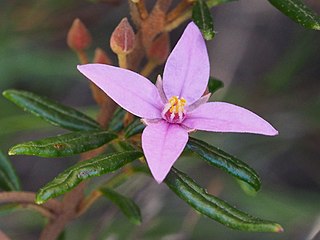
Boronia algida, commonly known as alpine boronia, is a flowering plant in the citrus family, Rutaceae and is endemic to south-eastern Australia. It is an erect shrub with many branches, pinnate leaves and white to bright pink, four-petalled flowers usually borne singly on the ends of branches.

Cyanothamnus anemonifolius, commonly known as narrow-leaved boronia or sticky boronia, is a flowering plant that is endemic to south-eastern Australia. It is a shrub with mostly pinnate leaves, with white to pale pink four-petalled flowers in leaf axils.

Cyanothamnus nanus, commonly known as the dwarf boronia or small boronia is a plant in the citrus family Rutaceae and is endemic to eastern Australia. It is a prostrate or low spreading shrub with simple or three-part leaves and white or pale pink four-petalled flowers.

Boronia barkeriana, commonly known as Barker's boronia, is a plant in the citrus family, Rutaceae and is endemic to eastern Australia. It is a shrub with ground-hugging branches, simple, toothed leaves and bright pink, four-petalled flowers.

Boronia grandisepala is a plant in the citrus family Rutaceae and is endemic to northern parts of the Northern Territory. It is an erect shrub with elliptic leaves and white, pink or burgundy-coloured, four-petalled flowers.

Boronia jucunda is a plant in the citrus family Rutaceae and is endemic to the far north-west of Australia. It is an erect shrub with many branches, pinnate leaves and white, four-petalled flowers. It is only known from a small area in the Kimberley region in Western Australia and in a national park in the Northern Territory.

Boronia lanceolata is a plant in the citrus family Rutaceae and is endemic to northern parts of the Northern Territory and Queensland. It is an erect shrub with many branches, elliptic to lance-shaped leaves and white or pink, four-petalled flowers. It is the most common boronia in the Northern Territory.

Boronia ternata is a plant in the citrus family Rutaceae and is endemic to the south-west of Western Australia. It is an erect shrub with many branches, simple or trifoliate leaves and white to pink four-petalled flowers.
Boronia amplectens is a plant in the citrus family Rutaceae and is only known from two specimens collected from the Arnhem Land plateau in the Northern Territory of Australia. It is a sprawling shrub with narrow elliptic leaves and four-petalled flowers.

Boronia angustisepala is a plant in the citrus family Rutaceae and is endemic to New South Wales, Australia. It is an erect shrub with many branches, pinnate leaves with up to eleven leaflets, and bright pink, four-petalled flowers.

Boronia decumbens is a plant in the citrus family Rutaceae and is endemic to northern parts of the Northern Territory. It is a low, spreading shrub with pinnate leaves and white to pink flowers with the four sepals larger than the four petals.

Boronia jensziae, commonly known as Andy Jensz's boronia or Hinchinbrook boronia, is a plant in the citrus family Rutaceae and is endemic to Hinchinbrook Island in Queensland. It is an erect, densely branched shrub with simple leaves and pink to white, four-petalled flowers usually arranged singly in leaf axils.

Boronia palasepala is a plant in the citrus family Rutaceae and is endemic to a small part of Queensland, Australia. It is an erect, rounded shrub with many branches, simple leaves and pink to white, four-petalled flowers.

Boronia prolixa is a species of plant in the citrus family Rutaceae and is endemic to a small area in the Northern Territory, Australia. It is a low-lying shrub with hairy branches, leaves and flower parts, simple leaves and white to pink flowers with the sepals longer and wider than the petals.
Boronia quadrilata is a species of plant in the citrus family Rutaceae and is endemic to a small area in the Northern Territory, Australia. It is an erect, glabrous shrub with simple, sessile, wedge-shaped leaves, pale yellow petals and green sepals that are longer and wider than the petals. It is only known from a population of about fifteen plants.

Boronia rupicola is a species of plant in the citrus family Rutaceae and is endemic to a small area in the Northern Territory, Australia. It is a small shrub with weeping branches, simple or pinnate leaves and small, green, inconspicuous flowers.

Boronia splendida is a species of plant in the citrus family, Rutaceae, and is endemic to Queensland, Australia. It is an erect shrub with most parts covered with star-like hairs and has simple, linear to narrow elliptic leaves, and pink to white, four-petalled flowers.

Boronia squamipetala is a species of plant in the citrus family, Rutaceae, and is endemic to Queensland, Australia. It is an erect shrub with pinnate leaves with between five and thirteen elliptic leaflets, and green to white, four-petalled flowers with hairy backs.

Boronia suberosa is a species of plant in the citrus family Rutaceae and is endemic to a small area in the Northern Territory, Australia. It is a shrub with weeping branches, simple leaves, and flowers with four small, white petals.
Boronia zeteticorum is a species of small, semi-prostrate shrub that is endemic to a restricted part of the Northern Territory. It has hairy branches, leaves and flower parts, simple leaves and white flowers with the sepals longer and wider than the petals.

















